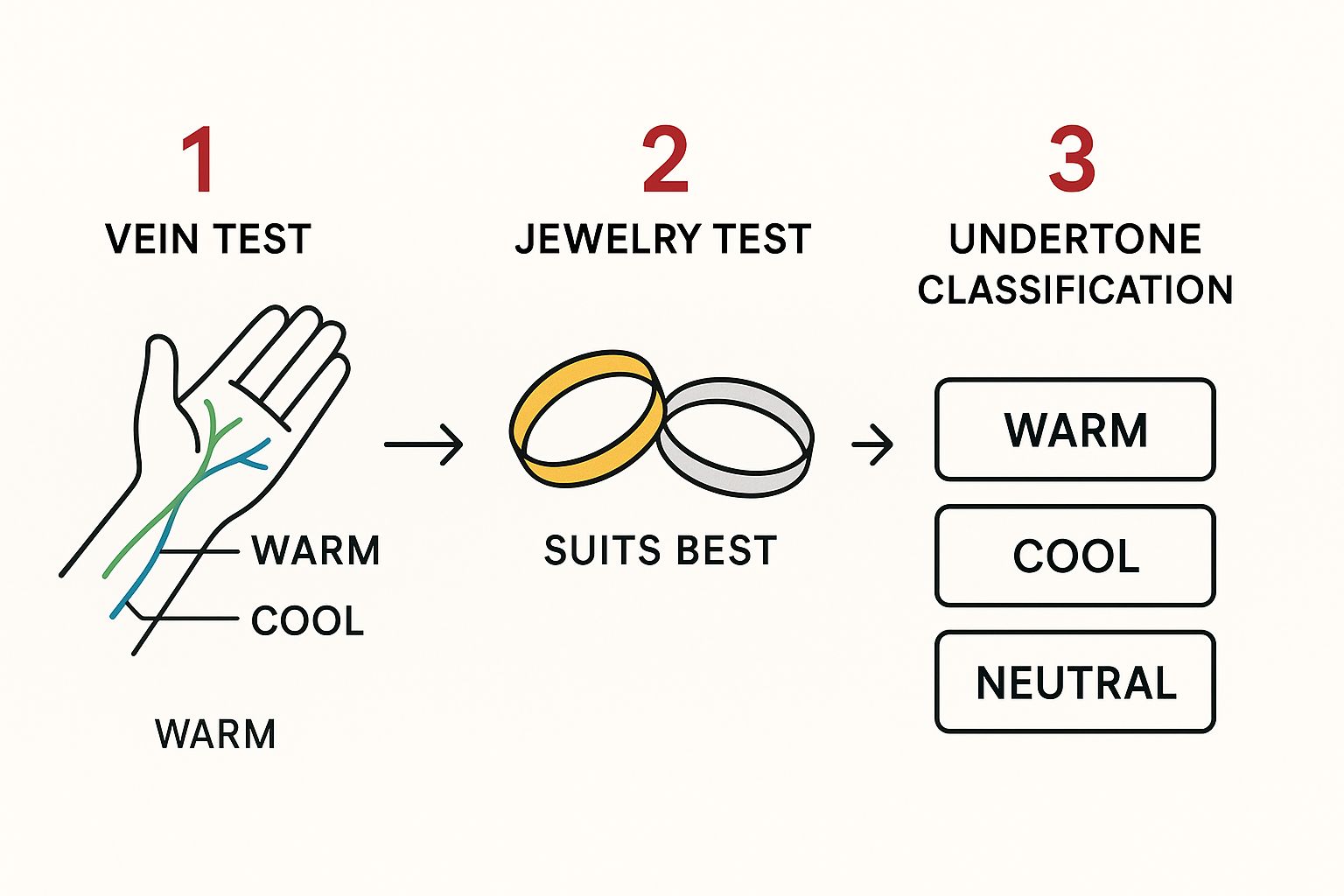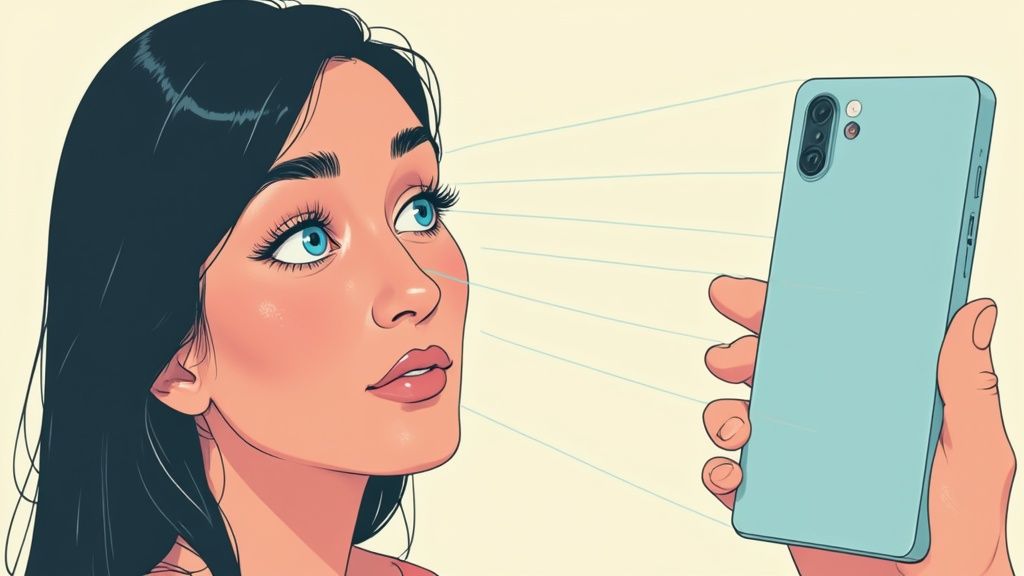Let’s be real: nailing your foundation shade is a total game-changer. It’s not just about covering things up; it's about creating a seamless, second-skin finish that boosts your confidence. Get it right, and your skin looks effortlessly even and smooth—the perfect canvas for everything else.
But we've all been there, right? Standing in a store under fluorescent lights, trying to guess which of the 50 beige bottles is the one. You end up with a shade that’s a little too dark and looks muddy, or one that’s too light and washes you out. It's a universal struggle.

This frustration is exactly why the beauty industry is pouring so much energy into solving the shade-matching puzzle.
A Quick Look At Shade-Matching Tech
Believe it or not, the global market for foundation shade finders was valued at a whopping USD 1.2 billion in 2023 and is still climbing. Why? Because an estimated 40–60% of all foundation returns happen because the shade was just plain wrong.
To tackle this, around 75% of major beauty brands have rolled out digital tools that promise over 90% accuracy. These apps and quizzes are making it easier than ever to get a solid starting point without leaving your house.
Your perfect foundation shade should look like you have nothing on at all. The goal is to create a seamless transition between your face and neck, making your skin look naturally flawless, not heavily covered.
Ultimately, the right shade just melts into your skin, leaving you looking perfected and even-toned. This guide will walk you through the practical, real-world steps to finally find your true match—and stop collecting a drawer full of expensive mistakes.
Once you’ve found your holy grail shade, the next step is mastering the application. A great formula deserves a great technique, especially with long-wear favorites. For pro tips on getting a flawless finish that lasts, check out this Estée Lauder Double Wear Guide.
Quick Guide to Your Perfect Foundation Shade
To break it down, here are the three most critical things to focus on when you're on the hunt for your perfect foundation shade. Getting these right will save you a ton of time, money, and frustration.
| Key Factor | What to Look For | Common Mistake to Avoid |
|---|---|---|
| Skin Undertone | The subtle hue beneath your skin's surface. Look for hints of pink/blue (cool), yellow/gold (warm), or a mix (neutral). | Ignoring your undertone and only focusing on how light or dark the shade is. |
| Swatch Location & Lighting | Apply stripes of foundation on your jawline, blending slightly. Check it in natural daylight to see how it truly looks. | Swatching on your hand or wrist and only checking it under harsh store lighting. |
| Skin Type & Formula | Your skin's needs. Oily skin often does best with matte or oil-free formulas, while dry skin loves hydrating, dewy finishes. | Choosing a trendy formula that doesn't work for your skin, causing it to look cakey, greasy, or patchy. |
Keep these three pillars in mind, and you're well on your way to finding a foundation you'll genuinely love.
Decode Your Skin's Undertone
Let's talk about one of the biggest reasons people struggle to find their perfect foundation match: undertones.
It’s easy to get sidetracked by your surface tone—the color you actually see in the mirror. That can change with a bit of sun or even just from season to season. But your undertone? That’s the subtle, consistent hue just beneath your skin's surface. It's permanent, and it’s the real secret to a seamless match.
Ever tried a foundation that looked great in the bottle but turned weirdly orange or ashy on your skin? That's what happens when undertones clash. Nailing your undertone first is a game-changer. It instantly narrows down your choices and gets you so much closer to that "second-skin" finish we're all after.
Simple At-Home Tests for Undertones
You don't need to be a pro to figure this out. A few quick checks right at home can give you all the clues you need. The most popular trick in the book is the vein test—it's fast, easy, and surprisingly on the money.
Just flip your wrist over in some good, natural daylight and take a look at your veins. Their color is a great indicator:
- Greenish Veins: If your veins have a green tint, you likely have a warm undertone. Think hints of yellow, gold, or peach in your skin.
- Bluish or Purple Veins: Seeing mostly blue or purple? You probably have a cool undertone. This means your skin has a pink, red, or blueish base.
- A Mix of Both: Can't really tell if they’re green or blue? If it looks like a bit of both, you’re most likely in the neutral undertone camp—a beautiful balance of warm and cool.
One of the biggest myths out there is that fair skin is always cool-toned and deep skin is always warm-toned. That’s just not true. Any skin depth, from the fairest porcelain to the richest espresso, can have warm, cool, or neutral undertones.
Still not sure? Try the jewelry trick. Which metal makes your skin pop? If gold jewelry brings out a glow and just looks right, you're probably warm-toned. If silver or platinum is more your thing and makes you look radiant, you’re likely cool-toned. And if you can rock both without skipping a beat? Hello, neutral.
This little infographic breaks it down visually to help you find your category.

Putting It All Together
Once you've cracked the code on your undertone, shopping becomes so much easier. You'll start noticing that brands often use letters in their shade names to guide you: W for warm, C for cool, and N for neutral. You might also see descriptive words like "golden," "rose," or "beige."
Understanding this is the key. It's why some shades look harmonious and others just feel… off. It’s the single most important step in finding a foundation that looks completely natural, like it was made just for you.
The Right Way to Swatch Foundation

Alright, you’ve figured out your undertone. Now comes the moment of truth: the swatch test.
For years, we were all told to swipe foundation on our wrists or the back of our hands. Let’s be real, this is probably the biggest reason so many of us have walked out with a mismatched shade. The skin there is almost always a completely different color and texture than your face.
To really know if a foundation is the one, you have to test it where you'll actually be wearing it. The sweet spot? Your jawline, blending down just a bit onto your neck. This is the only area that shows you how a shade bridges the gap between your face and neck, which is key for a seamless, natural look.
The Art of the Jawline Test
Instead of just dabbing one color and hoping for the best, a side-by-side comparison is the most effective way to see what truly melts into your skin.
Pick the three shades that look like they could be your match. Apply each one in a short, vertical stripe right on your jawline, leaving a little space between them. Don’t rub them in all the way—just gently pat the color into your skin so you can see it, with the edges slightly softened.
Pro Tip: Give it a minute. Foundation can sometimes oxidize, which is a fancy way of saying it can darken as it dries and mixes with your skin’s natural oils. Wait at least five to ten minutes before you make your final judgment.
Why Natural Light Is Non-Negotiable
This next part is maybe the most important tip I can give you: get out of the store. Seriously. The artificial lighting in most beauty departments is designed to be flattering, but it’s a total liar when it comes to foundation. Fluorescent lights can kill yellow tones, and warm lighting can make a shade that’s way too pink look just right.
Find a window, or even better, step outside. This is the only environment where you'll see the foundation's true color. Now, look at your swatches in a mirror. The right shade won’t look like a stripe of makeup at all. It will just… disappear.
The one that vanishes is your winner. It's that simple. This little trip into real-world lighting will save you from that sinking feeling of getting home and realizing your new foundation is a completely different color.
Once you've found your perfect shade, learning how to apply foundation with a sponge is a great next step for a flawless finish.
Test Driving Your Final Choice
If you're still a little unsure or you're about to splurge on a high-end bottle, never hesitate to ask for a sample.
Wearing a potential new foundation for a full day is the ultimate test drive. You get to see how the color looks and feels over several hours and in all the different places you go—from your office lighting to your car's rearview mirror. It's the best way to feel 100% confident before you commit.
Match the Formula to Your Skin Type
Finding the perfect shade is a huge win, but it's only half the battle. If you grab that shade in a formula that clashes with your skin, you’ll likely end up with a finish that’s patchy, greasy, or uncomfortably tight by noon.
Think of your skin type—oily, dry, or combination—as your roadmap. It guides you to a foundation that doesn’t just match your color, but also plays nicely with your skin's natural behavior. Choosing a formula that works with your skin, not against it, is the secret to getting that flawless, second-skin look we’re all after.
Foundations for Oily and Combination Skin
If your skin gets shiny, especially in the T-zone, you’ve probably experienced the dreaded foundation slip-and-slide. The key here is to look for formulas built for longevity and oil control.
A matte finish is usually the go-to. These foundations are made to soak up excess oil and keep shine at bay all day, leaving you with a velvety, non-greasy look. Powder foundations are also a fantastic choice, since their dry consistency naturally works against oiliness.
When you're scanning labels, keep an eye out for a few key terms:
- Oil-free: This is a big one. It means the formula won't pile more oil onto your skin.
- Mattifying: These products actively work to control shine for that perfect non-reflective finish.
- Non-comedogenic: This is crucial if you're prone to breakouts. It means the formula is designed to not clog your pores.
Formulas for Dry and Sensitive Skin
For anyone with dry skin, the wrong foundation can be a total nightmare. It can cling to dry patches and highlight every bit of texture you were trying to hide. Your goal is all about hydration and radiance. You want a formula that gives moisture back to your skin, making it look plump and healthy.
Look for foundations with a dewy, luminous, or radiant finish. They often contain skin-loving ingredients like hyaluronic acid or glycerin. Cream foundations and hydrating liquid formulas are your best friends here, as they provide both moisture and a supple finish.
If your skin is also sensitive, it's smart to learn which ingredients to avoid. We've got you covered with our complete guide to hypoallergenic makeup for sensitive skin.
I see this mistake all the time: piling on heavy, full-coverage foundation to hide redness or texture. Instead, try a buildable, hydrating formula. You can always spot-conceal any problem areas and let the rest of your skin look fresh and natural.
The Rise of Digital Shade Matching
Thankfully, figuring all this out online has gotten so much easier. The global market for shade matchers is expected to hit a massive USD 1,757.4 million by 2035, all because we demand digital convenience and accuracy.
It makes sense when you hear that up to 50% of foundation purchases are now influenced by these tools. Even more telling? 60% of shoppers won't even buy online without one. It really shows how important it is for people to get both the shade and the formula right. You can read more about it in this study on beauty tech adoption.
Use Technology to Your Advantage

Shopping for foundation online used to feel like a complete shot in the dark. Thankfully, the days of squinting at a grid of tiny, color-inaccurate squares and just hoping for the best are over. Brands are now bringing the shade-matching experience right to your living room with AI and AR.
These digital tools, usually found right on a brand's website or app, use your phone’s camera to do a quick scan of your skin. They analyze your unique skin tone, figure out your undertones, and then recommend the best shades from their lineup with some seriously impressive accuracy. It’s like having a virtual beauty consultant in your pocket.
Getting the Most Accurate Digital Match
Now, while these tools are a huge help, they're only as good as the picture you give them. A few simple tweaks can make a world of difference in how accurate your recommendation is.
To get the best possible analysis, try these quick tips:
- Find Natural Light: This is non-negotiable. Stand facing a window where the light is bright but not beaming directly in your face. Harsh overhead lighting or weird shadows will completely throw off the color reading.
- Go Bare-Faced: Make sure your skin is totally clean and free of any makeup. The tool needs to see your true skin tone, not the foundation you wore yesterday.
- Keep a Neutral Background: If you can, stand in front of a plain, neutral-colored wall. A busy or brightly colored background can confuse the camera's color sensors.
- Hold Your Phone Steady: Keep your phone at eye level and hold it still. This helps the camera get a clear, focused image to analyze.
Lots of people find it helpful to start with our Fungdation Shade Quiz, which pairs your own observations with smart tech to really narrow things down.
Think of these digital tools as your expert starting point. They're designed to give you a highly accurate shortlist—not the final verdict. They’ll get you down to the two or three shades that are most likely to be your perfect match.
The Power of Personalization in Beauty
This move toward digital help is all about meeting a real need. The beauty industry has made incredible strides in inclusivity, with top brands expanding their color offerings by 40–80% in just the last five years. It's not uncommon to see 50–60 shades now, which is amazing for reflecting the true diversity of skin tones out there.
Digital shade finders are the key to navigating these huge new ranges. In fact, consumer trials show these tools can hit a 95% satisfaction rate, and over 60% of new foundation launches now include one. It’s all about empowering you to find your match with confidence.
But remember, even the smartest AI can't replace that final, real-world test. Once you have your top recommendations, the next step is still the classic jawline swatch in natural daylight. Technology gets you incredibly close, but that final swipe is what confirms you’ve found "the one."
Your Foundation Matching Questions Answered
So, you’ve decoded your undertone and swatched like a pro, but a few tricky situations still have you stumped. Totally normal. Finding that perfect foundation shade can feel like the final boss level of makeup.
Let's clear up some of the most common hurdles people face. These quick, real-world answers will help you navigate those last few questions and finally feel confident in your choice.
What If I’m Between Two Shades?
This happens to pretty much everyone. The solution is surprisingly simple, even if it feels a little extra at first: buy both. It sounds like a splurge, but trust me, it’s the secret to a flawless, year-round match. Our skin isn't one flat color, and it definitely changes with the seasons—a little deeper in the summer, a touch lighter come winter.
Having two shades on hand means you can play mixologist and create a custom blend that’s just right for your skin on any given day. Add a drop of the deeper shade into your lighter one as you get more sun, and do the reverse as your tan fades. It’s a simple trick that ensures you always have a seamless, natural-looking finish.
Pro tip: Most makeup artists never use a single foundation shade straight from the bottle. They custom-mix to create dimension that looks like real skin, and you can absolutely do the same thing at home.
Should My Foundation Match My Neck or My Face?
The goal is to create a harmonious bridge between your face, neck, and chest. But let's be real, it’s super common for your face to be a slightly different color than your neck. This can happen from sun exposure (even with sunscreen!) or from using skincare products that brighten and even out your facial skin tone.
A good rule of thumb is to find a shade that disappears into your jawline and blends smoothly down your neck. If your neck is a lot lighter than your face, you can always sweep a little bronzer down your neck and onto your chest to tie everything together. You just want to avoid that "floating head" look where your face looks like a mask.
How Do I Adjust for Seasonal Skin Changes?
It's not just your skin tone that shifts with the seasons; its needs often change, too.
- Summer: You might find you need a slightly deeper shade and a formula with more oil control to stand up to heat and humidity.
- Winter: Skin often gets lighter and drier, which means a paler shade and a more hydrating, glowy formula might be your best friend.
This doesn't mean you have to buy a whole new foundation every six months. You can make easy adjustments. A few drops of liquid bronzer can warm up your winter foundation for summer. On the flip side, mixing in a hydrating primer or a drop of face oil can give a matte formula a dewier finish for that dry winter air. This kind of flexibility saves you from a drawer overflowing with half-used bottles.
At Axiology, we believe finding your perfect match should feel good, not frustrating. We make clean, vegan formulas designed to work with your skin for a finish that looks and feels like you. Explore our shades and find your perfect match today at AxiologyBeauty.com.





